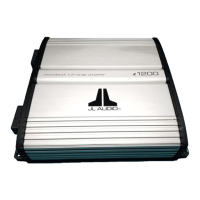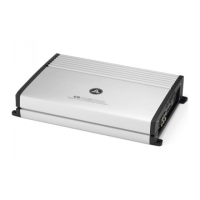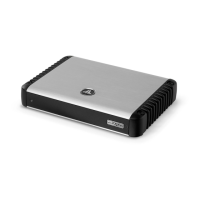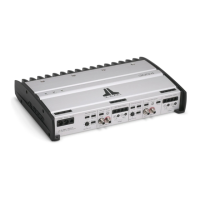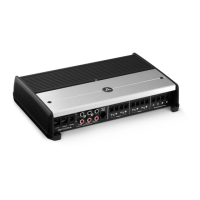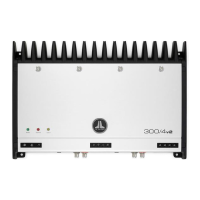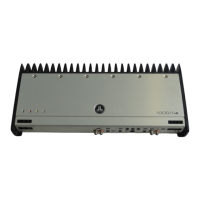6 | JL Audio - RD400/4 Owner’s Manual
TURNON OPTIONS
The RD400/4 can be switched on and off using
one of three methods, determined by the position
of the amplifier’s “Turn-On Mode” switch. Please
read these options and decide which is best suited
for your specific system.
1) +12V remote turn-on lead
2) DC offset-sensing turn-on circuit
3) Signal-sensing turn-on circuit
+12V Remote Turn-On: This is the preferred
method for turning the amplifier on/off. The
amplifier will turn on when +12V is present at
its “Remote” input and turn off when +12V is
switched off. This +12V remote turn-on signal
is typically controlled by a source unit or OEM
interface processor’s remote turn-on wire. The
RD400/4’s “Remote” turn-on connector will
accept 18 AWG – 12 AWG wire. To connect
the remote turn-on wire to the amplifier, first
back out the set screw on the top of the terminal
block, using the supplied 2.5 mm hex wrench.
Strip 1/2 inch (12 mm) of wire and insert the
bare wire into the terminal block, seating it
firmly so that no bare wire is exposed. While
holding the wire in the terminal, tighten the
set screw firmly, taking care not to strip the
head of the screw and making sure that the
wire is firmly gripped by the set screw.
INPUT SECTION
+12 VDC Ground Remote
If a source unit does not have a dedicated
remote turn-on output, consider one of the
following alternative turn-on options:
These methods are useful when a conventional
+12V remote turn-on signal is not available in a
system. These allow you to operate the amplifier
without having to locate a remote turn-on lead at
the source unit, which can be very useful when
interfacing the amplifier with OEM (factory)
audio systems that do not use conventional +12V
turn-on leads.
Depending on the characteristics of the audio
signal, one of the following methods may work
better than the other. We recommend trying DC
Offset-Sensing first as it does not require a long
delay to turn the system off after the signal is
shut off.
DC Offset-Sensing: The amplifier will turn on
and off by detecting the presence of a very small
DC signal (offset) that is typical in the audio
output of most OEM (factory) source units and
amplifiers. The amplifier will turn on and off in
reaction to the presence or absence of this DC
Offset. The sensitivity of this circuit is designed
for high-level (speaker level) signals, not for low-
level (preamp level) signals. The circuit senses
the input signal from CH. 1 only.
Signal-Sensing: The amplifier will turn on
and off by detecting the presence of a full-range
audio signal. After approximately 30 seconds,
the amplifier will shut off. The sensitivity of this
circuit is designed for high-level (speaker level)
signals, not for low-level (preamp level) signals.
The circuit is tuned to react to signals at mid-
range frequencies. This prevents false switching
from signals created by moving loudspeakers
that are in parallel with the amplifier’s input
signal. The circuit senses the input signal from
CH. 1 only.
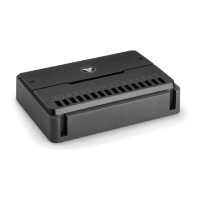
